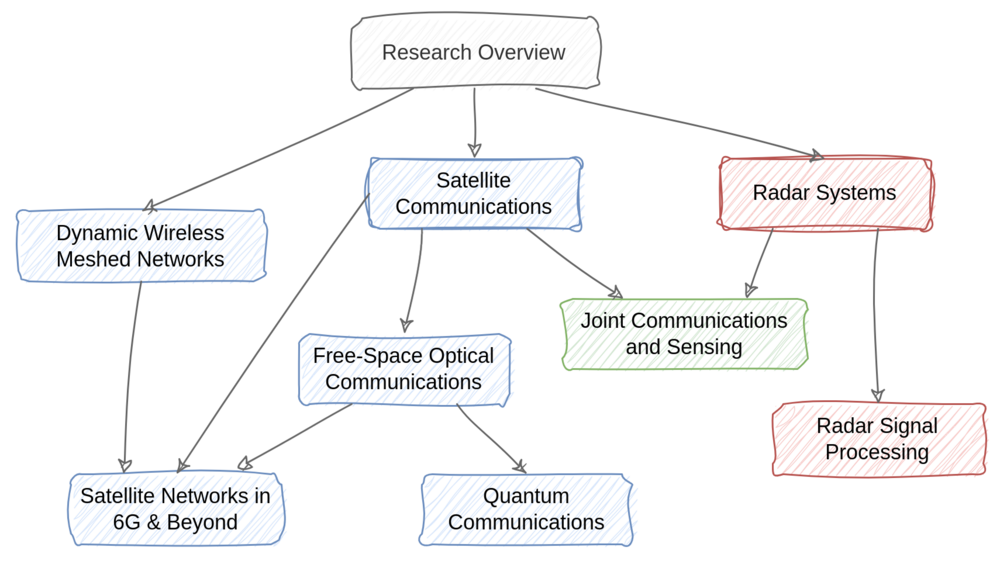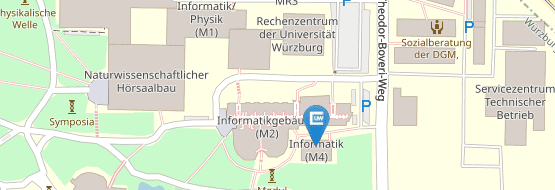Research
Dynamic Wireless Meshed Networks
In the research field of dynamic wireless meshed networks, we are particularly interested in two application scenarios:
- wirelessly connected drone swarms and
- satellite networks.
Additionally, our research delves into radio-based localization and decentralized synchronization techniques to improve network performance and resilience. This work has diverse applications, such as disaster management, precision agriculture and telecommunications.
One project in this research area is EnEFiS. You can find more details about this project on the Projects page.
Satellite Networks for 6G and Beyond
6G is taking the principles developed in 5G to the next level, focusing on the seamless integration of terrestrial mobile networks with Low Earth Orbit (LEO) satellites to ensure not only extensive coverage but also ultra-low latency, which is crucial for emerging technologies and applications. In this pursuit, ongoing research is concentrated on multiple key fronts. First, the development of efficient handover mechanisms between terrestrial and satellite networks is essential to maintain a continuous, uninterrupted connection. Second, sophisticated routing strategies are being devised to ensure data travels optimally through this hybrid network. Furthermore, scheduling algorithms are being fine-tuned to allocate resources effectively in real-time, enabling better network management. Additionally, advanced Multiple-Input Multiple-Output (MIMO) transmission techniques are explored to enhance data throughput and mitigate interference. These collective efforts aim to make 6G the catalyst for transformative connectivity, powering innovations we can only begin to imagine.
One project in this research area is UWE-5. You can find more details about this project on the Projects page.
Free-Space Optical Communications
Our free-space optical communications research focuses on breakthrough modulation techniques that improve both robustness and data transmission rates. We are also exploring the potential of modulated retro-reflectors (MRR), which we are deploying on drones to achieve high-speed data transmission from the drone to the ground with only one ground-mounted laser. This innovation is promising for scenarios where large amounts of data from sensors, such as high-resolution cameras, need to be transmitted quickly to enable seamless information exchange across a wide range of applications.
Quantum Communications
Our research in this area encompasses a multi-faceted exploration of quantum communications and network security, with a focus on the implementation of Quantum Key Distribution (QKD) protocols, including BB84 and EPR-based methods. We strive to minimise security compromises in these protocols by addressing the challenges posed by noise and channel loss, while validating our results through rigorous experiments and simulations. We are also strategically looking at integrating advanced routing protocols into quantum networks to increase their robustness against potential attacks. By simultaneously advancing QKD and routing algorithms, our research promises to provide novel secure communications and encryption solutions for protecting the exchange of sensitive data in various domains.
Joint Communications and Sensing
Our research in Joint Communications And Sensing (JCAS) focuses primarily on satellite communications. In particular, we focus on the use of advanced techniques such as delay Doppler modulation techniques, including OTFS (Orthogonal Time Frequency Space) modulation, which we combine with MIMO (Multiple-Input Multiple-Output) technologies to not only improve the performance of the communication system, but also to estimate parameters such as range, speed and angle. These techniques are used for docking manoeuvres in space, controlling satellite swarms and detecting space debris. A key advantage of our concept is that it uses the existing radio infrastructure for detection, so no additional hardware is required.
In addition to JCAS as described above, we are particularly interested in the convergence of communication and Light Detection And Ranging (LiDAR) systems, which, for example, enable optical communication between two vehicles equipped with LiDAR systems to detect the environment.
Radar Signal Processing
Our research encompasses radar signal processing, a critical field that involves the development of advanced techniques for the detection, analysis, and interpretation of radar signals. We also explore the emerging domain of optical quantum sensing, investigating quantum technologies to enhance sensing capabilities in areas like precision measurement and remote sensing. These two research areas contribute to the advancement of cutting-edge technologies with applications in remote sensing and various scientific disciplines.



